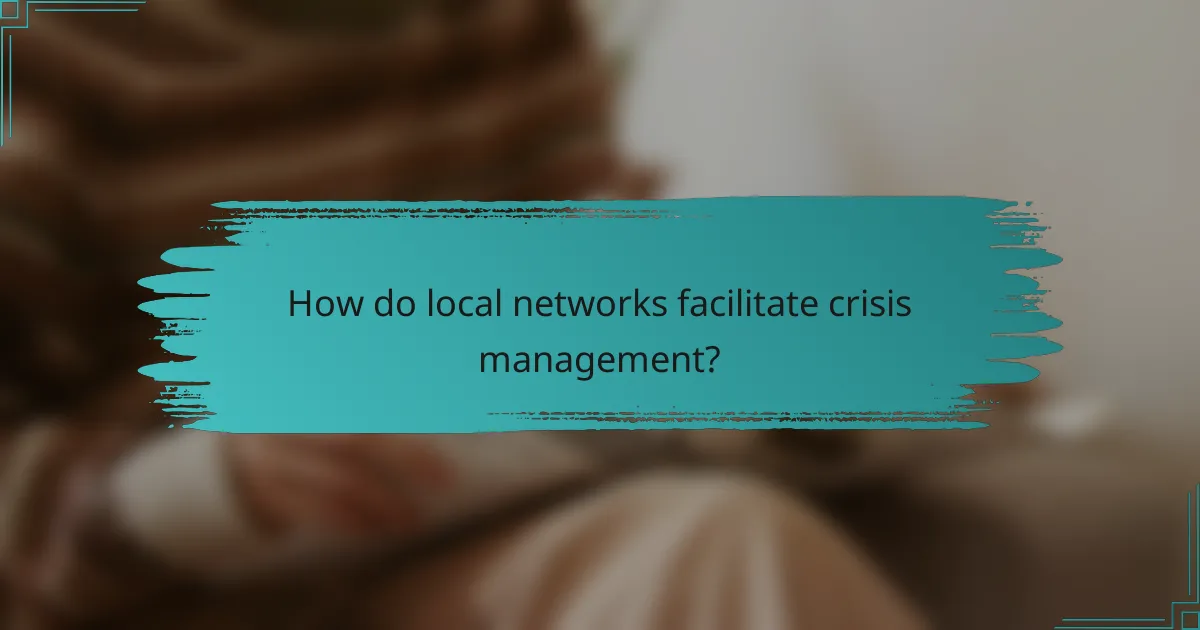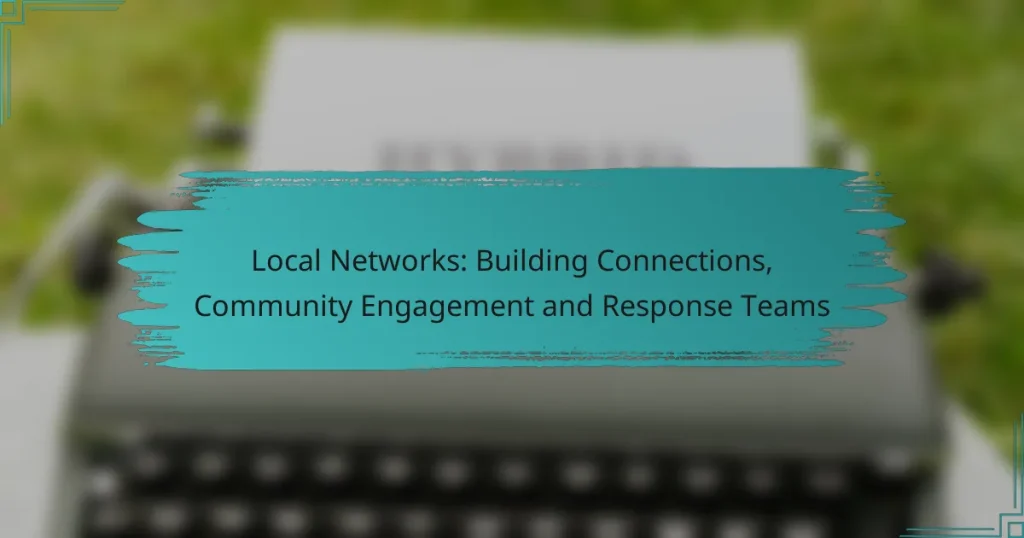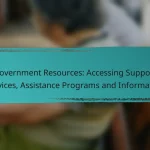Local networks are essential for enhancing community engagement by connecting residents and encouraging participation in initiatives that strengthen the community. By fostering collaboration and resource sharing, these networks empower residents to respond effectively to challenges and emergencies. Establishing clear communication and training for local response teams further enhances their ability to manage crises and support community resilience.

How can local networks enhance community engagement in South Africa?
Local networks in South Africa can significantly boost community engagement by fostering connections among residents, facilitating collaboration, and promoting participation in local initiatives. These networks create a platform for residents to share resources, ideas, and support, ultimately strengthening the community fabric.
Increased participation in local events
Local networks encourage higher turnout at community events by promoting awareness and providing a sense of belonging. When residents are connected, they are more likely to attend events such as markets, festivals, and workshops, which can enhance community spirit.
To maximize participation, organizers can utilize social media and community boards to share event details, ensuring that information reaches a wider audience. Engaging local influencers or community leaders can also help attract more attendees.
Strengthened relationships among residents
Building local networks fosters stronger relationships among residents by creating opportunities for interaction and collaboration. Regular meetings, social gatherings, and volunteer activities can help individuals connect on a personal level, leading to a more cohesive community.
Encouraging open communication through platforms like WhatsApp groups or community forums can further enhance these relationships. Residents can share experiences, offer support, and collaborate on local projects, reinforcing their ties to one another.
Improved access to local resources
Local networks improve access to resources by connecting residents with information and services available in their area. This can include access to local businesses, educational programs, and health services, which are often underutilized due to lack of awareness.
Creating a centralized resource directory, either online or in print, can help residents easily find what they need. Additionally, organizing resource fairs can showcase local offerings, ensuring that community members know how to access essential services.

What are effective strategies for building local response teams?
Effective strategies for building local response teams include establishing clear communication channels, providing comprehensive training, and fostering collaboration with community stakeholders. These elements ensure that teams are well-prepared to respond to emergencies and engage effectively with the community.
Training programs for volunteers
Training programs for volunteers are essential for equipping team members with the necessary skills to respond effectively during emergencies. These programs should cover first aid, emergency response protocols, and community engagement techniques.
Consider conducting regular workshops and simulations to reinforce learning and build confidence. Engaging local experts to lead these sessions can enhance the training’s credibility and effectiveness.
Collaboration with local authorities
Collaboration with local authorities is crucial for the success of response teams. Establishing partnerships with police, fire departments, and emergency medical services can streamline communication and resource sharing during crises.
Regular meetings with local officials can help align the response team’s objectives with community needs and ensure that all parties are aware of their roles in an emergency. This collaboration can also facilitate access to funding and resources.
Utilization of social media platforms
Utilizing social media platforms can significantly enhance the outreach and effectiveness of local response teams. These platforms allow teams to disseminate information quickly and engage with the community in real-time.
Creating dedicated pages or groups on popular platforms can help share updates, recruit volunteers, and promote training events. It’s important to maintain active communication and respond promptly to community inquiries to build trust and encourage participation.

How do local networks facilitate crisis management?
Local networks play a crucial role in crisis management by enabling swift communication and collaboration among community members and organizations. These networks enhance the ability to respond effectively to emergencies, ensuring that resources and information are shared promptly.
Rapid information dissemination
Rapid information dissemination is vital during a crisis, as timely updates can significantly influence public safety and response actions. Local networks utilize various communication channels, such as social media, text alerts, and community meetings, to spread critical information quickly.
For instance, during natural disasters, local authorities can inform residents about evacuation routes or shelter locations within minutes, reducing confusion and panic. Establishing a reliable communication plan before a crisis occurs can enhance the speed and effectiveness of information sharing.
Coordinated response efforts
Coordinated response efforts involve multiple stakeholders working together to manage a crisis effectively. Local networks facilitate collaboration between emergency services, community organizations, and volunteers, ensuring that everyone is aligned in their response strategies.
For example, during a public health emergency, local health departments can coordinate with hospitals and non-profits to provide necessary resources, such as medical supplies and personnel. Regular training and joint exercises can improve coordination and readiness for real-life scenarios.
Resource allocation during emergencies
Effective resource allocation is essential for managing crises, as it determines how quickly and efficiently aid can be delivered. Local networks help identify available resources, such as food, shelter, and medical assistance, and ensure they are distributed where they are most needed.
In practice, this might involve setting up a centralized hub for resource distribution, where community members can access supplies during an emergency. Establishing partnerships with local businesses and organizations can enhance resource availability and streamline the allocation process.

What role do local businesses play in community networks?
Local businesses are vital in fostering community networks by providing resources, support, and engagement opportunities. They help create a sense of belonging and collaboration among residents, enhancing overall community well-being.
Sponsorship of community events
Local businesses often sponsor community events, which can range from festivals to charity runs. This sponsorship not only provides financial support but also increases visibility for the businesses involved, creating a win-win situation.
For example, a local café might sponsor a neighborhood block party, offering free coffee and pastries. This not only attracts customers but also strengthens ties with the community, encouraging repeat business.
Partnerships with local organizations
Businesses frequently form partnerships with local organizations, such as schools, non-profits, and sports teams. These collaborations can lead to joint initiatives that benefit both the organization and the business.
For instance, a local hardware store might partner with a community garden project, providing tools and supplies in exchange for promotional opportunities. Such partnerships enhance community engagement and can lead to increased customer loyalty.
Promotion of local products and services
Promoting local products and services is another key role of businesses in community networks. By highlighting locally made goods, businesses can support their neighbors and stimulate the local economy.
For example, a boutique might feature handmade items from local artisans, creating a unique shopping experience that attracts customers interested in supporting their community. This not only boosts sales for the boutique but also elevates the profiles of local creators.

How can technology improve local network effectiveness?
Technology enhances local network effectiveness by facilitating communication, enabling data-driven decision-making, and streamlining resource sharing. By leveraging mobile apps, data analytics, and online platforms, communities can better engage with residents and respond to their needs efficiently.
Mobile apps for community communication
Mobile applications serve as vital tools for fostering communication within local networks. They allow residents to receive real-time updates, report issues, and engage in discussions, creating a more connected community. For instance, apps like Nextdoor or local government platforms can facilitate neighborhood watch programs or community events.
When implementing mobile apps, consider user accessibility and ease of use. Ensure that the app is compatible with various devices and includes features like push notifications to keep users informed. Regular updates and community feedback can enhance functionality and user satisfaction.
Data analytics for community needs assessment
Data analytics can significantly improve the understanding of community needs by analyzing trends and patterns. By collecting data from surveys, social media, and local services, communities can identify pressing issues and allocate resources effectively. For example, analyzing traffic data can help determine where to place new bike lanes or traffic signals.
To utilize data analytics effectively, establish clear objectives for what you want to learn about your community. Use tools like Google Analytics or local data platforms to gather insights. Be cautious of privacy concerns; ensure that data collection complies with local regulations and respects residents’ privacy.
Online platforms for resource sharing
Online platforms facilitate resource sharing among community members, enhancing collaboration and support. Websites and apps like Freecycle or local Facebook groups allow residents to exchange goods, services, or information, reducing waste and fostering community spirit. These platforms can also be used to organize volunteer efforts or share local events.
When setting up an online resource-sharing platform, focus on user-friendly design and clear guidelines for participation. Promote the platform through local channels to encourage engagement. Monitor activity to ensure a safe and respectful environment, addressing any issues promptly to maintain community trust.

What are the challenges faced by local networks in South Africa?
Local networks in South Africa encounter several challenges that hinder their effectiveness, including limited funding and inadequate resources. These obstacles can significantly impact community engagement and the ability to respond to local needs.
Lack of funding and resources
The lack of funding and resources is a primary challenge for local networks in South Africa. Many community organizations rely on grants and donations, which can be inconsistent and insufficient to meet operational needs. This financial instability often limits their capacity to implement programs and engage effectively with the community.
To address this issue, local networks can explore diverse funding sources, such as partnerships with businesses, crowdfunding, and government grants. Establishing a clear budget and prioritizing essential activities can also help maximize the impact of available resources.
Common pitfalls include relying solely on a single funding source or failing to document the outcomes of funded projects, which can deter future support. Building a strong case for funding by showcasing successful initiatives can attract more investment and resources.


